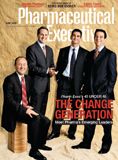Tightening the Chain
Pharmaceutical Executive
EU makes plans to police its supply chain
Want to read a scary fact? The World Health Organization estimates that 10 percent of all drugs in the supply chain are fakes.

Sarah Houlton
Counterfeit and diverted drugs are not just a problem for the developing world, they're a growing problem everywhere. And it's not just lifestyle drugs like Viagra and Cialis sold via pushers on the Internet; an increasing number of life saving drugs—including Casodex, Plavix, and Zyprexa—are being copied. (Fakes of all three were found on pharmacy shelves in the UK last year.)
"The distribution system is completely porous," claims Jim Thompson, chair of the European Alliance for Access to Safe Medicines. "There is no single legal institution controlling it—it's like the Wild West. We desperately need legislation to tighten it up."
Point of Entry
The European Commission (EC) reports that 2.7 million fake meds were seized at EU borders in 2006—an increase of nearly 400 percent over 2005. And with the expansion of the EU, there are now many land borders with Russia and Ukraine—two major sources of counterfeit drugs.
Currently, it's almost impossible to know where a drug pack is located en route from manufacturer to patient. "It could be made in the UK and destined for the Greek market, where wholesalers sell it to parallel traders, or it could have passed through several different countries before it appears on UK pharmacy shelves," Thompson says.
This fragmented distribution system provides many opportunities for unscrupulous traders to get their products into the supply chain, according to Andrew Calvert, director of business development at Frost & Sullivan. "Because parallel traders repackage products, it's extremely difficult to trace where illegitimate activity is happening," he says.
Keeping Track
There may be an improvement on the horizon, however, as the EC is running a public consultation on drug distribution on the Continent. "One of the most promising ways for solving the problem is mass serialization," says Calvert. "If the manufacturer gives every pack a unique identifier, it can be tracked." The process is analogous to serial numbers routinely given to cars and electronics, and would make it easier for products to be recalled if a manufacturing issue shows up.
In its initial consultation document, the EC suggests that mass serialization could provide a method for keeping track of where a drug has been, making it more difficult for fakes to enter the supply chain. Several systems have been proposed, and European trade association EFPIA is starting a pilot scheme using a 2-D bar code system to apply mass serial codes to packs later this year.
A number of EU countries have already started implementing mass serialization, with some success. Furthest advanced is Belgium, where a 2005 law mandates that all reimbursed drug packs have a bar code that enables the pharmacist to authenticate the product's serial number. All product serial numbers are loaded onto an Internet-based system that will automatically freeze the computer if it picks up a problem, such as expired products, recalled drugs, or false serial numbers. Similar systems are being rolled out in Greece and Italy.
In true European style, however, there's no standardized way of bar coding product. "That's why EFPIA's solution of one 2-D code for the whole of Europe would be more elegant," says Gary Noon, chief executive of Aegate, which supplies online authentication systems.
The advantage of bar codes is that they are cheap and easy to implement, and the serial number provides security against counterfeiting, rather than a device such as an RFID applied to the pack. "Track-and-trace in the US is a classic way of how not to do it," says Frost & Sullivan's Calvert. "It's expensive and non-binding. The system in Belgium is working because it's cheaper, simpler, and enshrined in law."
The EC consultation is due to report back later this year, and EFPIA believes that "decisive and urgent action" is required to enhance product security. Some companies are already taking action—according to Noon, AstraZeneca has implemented mass serialization globally for Nexium, and there is a growing belief that this is the way ahead.
Sarah Houlton is Pharmaceutical Executive's global correspondent. She can be reached at sarah@owlmedia.co.uk

Addressing Disparities in Psoriasis Trials: Takeda's Strategies for Inclusivity in Clinical Research
April 14th 2025LaShell Robinson, Head of Global Feasibility and Trial Equity at Takeda, speaks about the company's strategies to engage patients in underrepresented populations in its phase III psoriasis trials.
Beyond the Prescription: Pharma's Role in Digital Health Conversations
April 1st 2025Join us for an insightful conversation with Jennifer Harakal, Head of Regulatory Affairs at Canopy Life Sciences, as we unpack the evolving intersection of social media and healthcare decisions. Discover how pharmaceutical companies can navigate regulatory challenges while meaningfully engaging with consumers in digital spaces. Jennifer shares expert strategies for responsible marketing, working with influencers, and creating educational content that bridges the gap between patients and healthcare providers. A must-listen for pharma marketers looking to build trust and compliance in today's social media landscape.
Bristol Myers Squibb’s Cobenfy Falls Short in Phase III Trial as Add On Therapy for Schizophrenia
April 23rd 2025In the Phase III ARISE trial, Cobenfy administered as an adjunctive treatment to atypical antipsychotics for patients with inadequately controlled schizophrenia did not achieve statistically significant improvements.